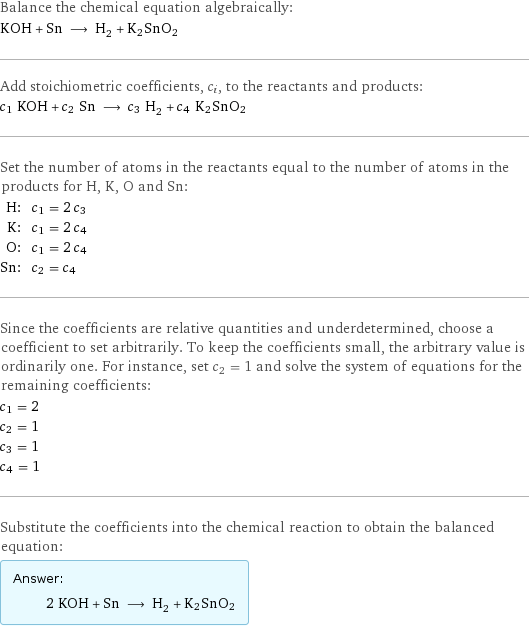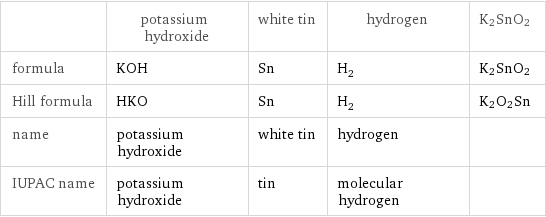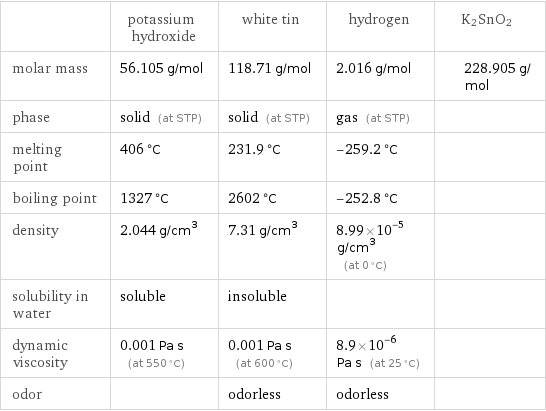Input interpretation

KOH potassium hydroxide + Sn white tin ⟶ H_2 hydrogen + K2SnO2
Balanced equation

Balance the chemical equation algebraically: KOH + Sn ⟶ H_2 + K2SnO2 Add stoichiometric coefficients, c_i, to the reactants and products: c_1 KOH + c_2 Sn ⟶ c_3 H_2 + c_4 K2SnO2 Set the number of atoms in the reactants equal to the number of atoms in the products for H, K, O and Sn: H: | c_1 = 2 c_3 K: | c_1 = 2 c_4 O: | c_1 = 2 c_4 Sn: | c_2 = c_4 Since the coefficients are relative quantities and underdetermined, choose a coefficient to set arbitrarily. To keep the coefficients small, the arbitrary value is ordinarily one. For instance, set c_2 = 1 and solve the system of equations for the remaining coefficients: c_1 = 2 c_2 = 1 c_3 = 1 c_4 = 1 Substitute the coefficients into the chemical reaction to obtain the balanced equation: Answer: | | 2 KOH + Sn ⟶ H_2 + K2SnO2
Structures

+ ⟶ + K2SnO2
Names

potassium hydroxide + white tin ⟶ hydrogen + K2SnO2
Equilibrium constant
![Construct the equilibrium constant, K, expression for: KOH + Sn ⟶ H_2 + K2SnO2 Plan: • Balance the chemical equation. • Determine the stoichiometric numbers. • Assemble the activity expression for each chemical species. • Use the activity expressions to build the equilibrium constant expression. Write the balanced chemical equation: 2 KOH + Sn ⟶ H_2 + K2SnO2 Assign stoichiometric numbers, ν_i, using the stoichiometric coefficients, c_i, from the balanced chemical equation in the following manner: ν_i = -c_i for reactants and ν_i = c_i for products: chemical species | c_i | ν_i KOH | 2 | -2 Sn | 1 | -1 H_2 | 1 | 1 K2SnO2 | 1 | 1 Assemble the activity expressions accounting for the state of matter and ν_i: chemical species | c_i | ν_i | activity expression KOH | 2 | -2 | ([KOH])^(-2) Sn | 1 | -1 | ([Sn])^(-1) H_2 | 1 | 1 | [H2] K2SnO2 | 1 | 1 | [K2SnO2] The equilibrium constant symbol in the concentration basis is: K_c Mulitply the activity expressions to arrive at the K_c expression: Answer: | | K_c = ([KOH])^(-2) ([Sn])^(-1) [H2] [K2SnO2] = ([H2] [K2SnO2])/(([KOH])^2 [Sn])](../image_source/1897c563d28b473b422559e78089feaa.png)
Construct the equilibrium constant, K, expression for: KOH + Sn ⟶ H_2 + K2SnO2 Plan: • Balance the chemical equation. • Determine the stoichiometric numbers. • Assemble the activity expression for each chemical species. • Use the activity expressions to build the equilibrium constant expression. Write the balanced chemical equation: 2 KOH + Sn ⟶ H_2 + K2SnO2 Assign stoichiometric numbers, ν_i, using the stoichiometric coefficients, c_i, from the balanced chemical equation in the following manner: ν_i = -c_i for reactants and ν_i = c_i for products: chemical species | c_i | ν_i KOH | 2 | -2 Sn | 1 | -1 H_2 | 1 | 1 K2SnO2 | 1 | 1 Assemble the activity expressions accounting for the state of matter and ν_i: chemical species | c_i | ν_i | activity expression KOH | 2 | -2 | ([KOH])^(-2) Sn | 1 | -1 | ([Sn])^(-1) H_2 | 1 | 1 | [H2] K2SnO2 | 1 | 1 | [K2SnO2] The equilibrium constant symbol in the concentration basis is: K_c Mulitply the activity expressions to arrive at the K_c expression: Answer: | | K_c = ([KOH])^(-2) ([Sn])^(-1) [H2] [K2SnO2] = ([H2] [K2SnO2])/(([KOH])^2 [Sn])
Rate of reaction
![Construct the rate of reaction expression for: KOH + Sn ⟶ H_2 + K2SnO2 Plan: • Balance the chemical equation. • Determine the stoichiometric numbers. • Assemble the rate term for each chemical species. • Write the rate of reaction expression. Write the balanced chemical equation: 2 KOH + Sn ⟶ H_2 + K2SnO2 Assign stoichiometric numbers, ν_i, using the stoichiometric coefficients, c_i, from the balanced chemical equation in the following manner: ν_i = -c_i for reactants and ν_i = c_i for products: chemical species | c_i | ν_i KOH | 2 | -2 Sn | 1 | -1 H_2 | 1 | 1 K2SnO2 | 1 | 1 The rate term for each chemical species, B_i, is 1/ν_i(Δ[B_i])/(Δt) where [B_i] is the amount concentration and t is time: chemical species | c_i | ν_i | rate term KOH | 2 | -2 | -1/2 (Δ[KOH])/(Δt) Sn | 1 | -1 | -(Δ[Sn])/(Δt) H_2 | 1 | 1 | (Δ[H2])/(Δt) K2SnO2 | 1 | 1 | (Δ[K2SnO2])/(Δt) (for infinitesimal rate of change, replace Δ with d) Set the rate terms equal to each other to arrive at the rate expression: Answer: | | rate = -1/2 (Δ[KOH])/(Δt) = -(Δ[Sn])/(Δt) = (Δ[H2])/(Δt) = (Δ[K2SnO2])/(Δt) (assuming constant volume and no accumulation of intermediates or side products)](../image_source/ca8c1a2d99d699de84a3460aa4b3f019.png)
Construct the rate of reaction expression for: KOH + Sn ⟶ H_2 + K2SnO2 Plan: • Balance the chemical equation. • Determine the stoichiometric numbers. • Assemble the rate term for each chemical species. • Write the rate of reaction expression. Write the balanced chemical equation: 2 KOH + Sn ⟶ H_2 + K2SnO2 Assign stoichiometric numbers, ν_i, using the stoichiometric coefficients, c_i, from the balanced chemical equation in the following manner: ν_i = -c_i for reactants and ν_i = c_i for products: chemical species | c_i | ν_i KOH | 2 | -2 Sn | 1 | -1 H_2 | 1 | 1 K2SnO2 | 1 | 1 The rate term for each chemical species, B_i, is 1/ν_i(Δ[B_i])/(Δt) where [B_i] is the amount concentration and t is time: chemical species | c_i | ν_i | rate term KOH | 2 | -2 | -1/2 (Δ[KOH])/(Δt) Sn | 1 | -1 | -(Δ[Sn])/(Δt) H_2 | 1 | 1 | (Δ[H2])/(Δt) K2SnO2 | 1 | 1 | (Δ[K2SnO2])/(Δt) (for infinitesimal rate of change, replace Δ with d) Set the rate terms equal to each other to arrive at the rate expression: Answer: | | rate = -1/2 (Δ[KOH])/(Δt) = -(Δ[Sn])/(Δt) = (Δ[H2])/(Δt) = (Δ[K2SnO2])/(Δt) (assuming constant volume and no accumulation of intermediates or side products)
Chemical names and formulas

| potassium hydroxide | white tin | hydrogen | K2SnO2 formula | KOH | Sn | H_2 | K2SnO2 Hill formula | HKO | Sn | H_2 | K2O2Sn name | potassium hydroxide | white tin | hydrogen | IUPAC name | potassium hydroxide | tin | molecular hydrogen |
Substance properties

| potassium hydroxide | white tin | hydrogen | K2SnO2 molar mass | 56.105 g/mol | 118.71 g/mol | 2.016 g/mol | 228.905 g/mol phase | solid (at STP) | solid (at STP) | gas (at STP) | melting point | 406 °C | 231.9 °C | -259.2 °C | boiling point | 1327 °C | 2602 °C | -252.8 °C | density | 2.044 g/cm^3 | 7.31 g/cm^3 | 8.99×10^-5 g/cm^3 (at 0 °C) | solubility in water | soluble | insoluble | | dynamic viscosity | 0.001 Pa s (at 550 °C) | 0.001 Pa s (at 600 °C) | 8.9×10^-6 Pa s (at 25 °C) | odor | | odorless | odorless |
Units
